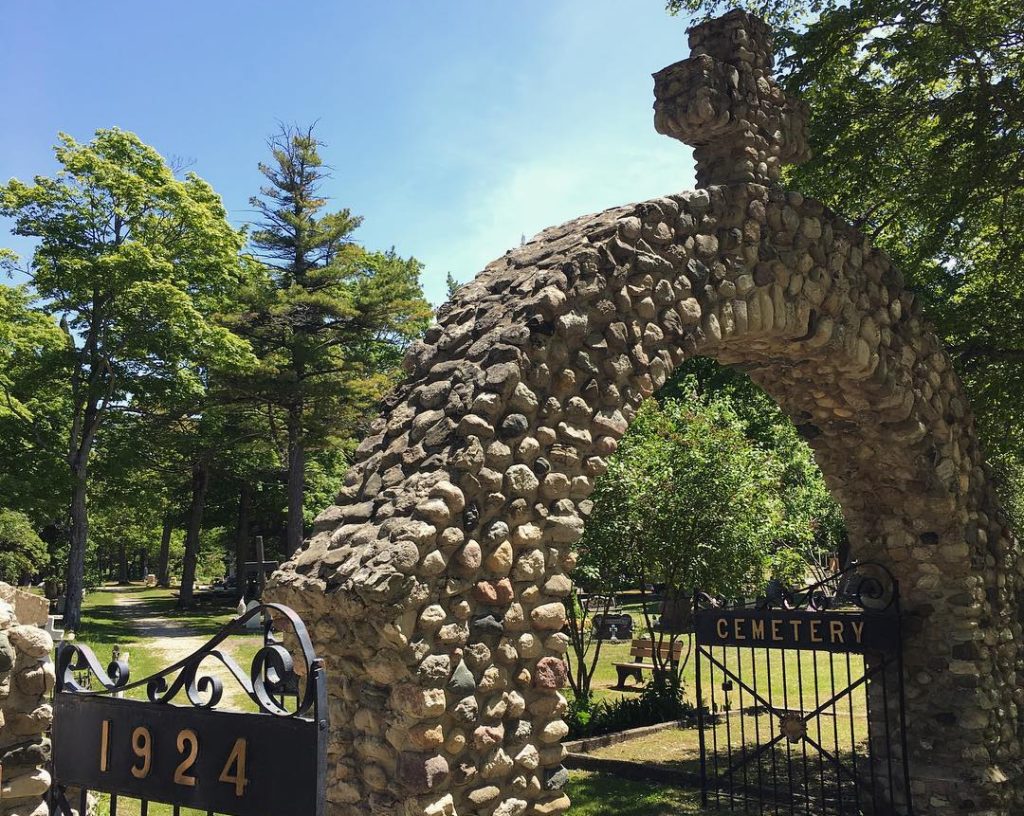So many people have contributed to the history and development of Mackinac Island, yet so often the markers above their final resting places offer little more information than their names. For example, among the hundreds of grave sites in Mackinac Island’s Ste. Ann’s Cemetery is one shared by Charles and Tulley O’Malley.
The headstone above where the brothers were laid to rest side by side show that they were born over 3,000 miles away, in Ireland. Yet, it tells nothing of their influence on Mackinac Island that is felt still to this day.
For one thing, Charles O’Malley built the Island House Hotel, which was one of the first summer hotels on Mackinac Island and remains among the leading destinations for overnight visitors. In fact, Island House Hotel has been recognized as one of the Top 10 hotels in the entire Midwest!
But the influence of the O’Malley brothers goes much deeper than that. To tell that tale, let’s go back to the Irish Isle…
Irish Influence on Mackinac Island Through the O’Malley Brothers
Charles O’Malley was born in 1807 in Newport, a fishing town in County Mayo on the west coast of Ireland. He was identified as a prospective Catholic priest and began studying for that, only to change course on multiple occasions.
First, Charles and Tulley, his younger brother, left Ireland for Canada where he became involved with the university, perhaps both as a student and teacher. Then, in 1832 in the midst of a deadly cholera outbreak – introduced, ironically, by a boat of immigrants from Ireland – the brothers left Montreal for the fresh air of the Great Lakes. They ended up on Mackinac Island, where Charles found work in the fur trade, according to an obituary:
“True enough, his knowledge of Latin, Gaelic and Greek, of philosophy and theology, were now a dead capital; but his general education, his natural tact for business, and the mastery of the French language which he soon acquired – a large part of the business transactions in Mackinac being then carried on in that tongue – not only rendered him eminently useful to his employers, but also made him feel so much at home in that new career that he never returned to the pursuits of his earlier youth.”
With Tulley’s help, Charles soon opened a general store to serve the fur traders and other visitors who frequented Mackinac Island. He later served as a Justice of the Peace on Mackinac Island and became the area’s representative in the Michigan State Legislature, rising to Speaker Pro-Tem in 1849. Tulley, meanwhile, became a successful lumberman and served as sheriff of Mackinac County.
But as the obituary states, Charles O’Malley’s biggest impact came in using his business success to help fellow Irishmen come to Mackinac Island during Ireland’s great potato famine:
“At that period, the Irish nationality was still unrepresented on Mackinac Island, except perhaps by a few soldiers in the garrison. But their turn now came. For, having become aware of the advantages of the locality through the young man’s letters, a few friends soon joined him. Others followed. All proved thrifty; and the consequence was that in the course of forty years the Irish (almost exclusively of Mayo) became, as it were, the bone and sinew of the Mackinac population.”
The Irish Legacy on Mackinac Island
While only a small share of the 1 million-plus Irish immigrants who came to the United States during the potato famine ended up on Mackinac Island, the influx had a lasting impact on the population. By 1850, Mackinac Island counted 181 Irish from 26 different families, according to Phil Porter, director emeritus of Mackinac State Historic Parks. Then another 10 Irish families came to Mackinac Island over the next 20 years, Porter writes in “Mackinac: An Island Famous in These Regions.”
Among the Irish countrymen whom O’Malley helped immigrate to Mackinac Island were Dominick Murray, founder of the Murray Hotel, his niece, Bridget Donnelly, who built the Cloghaun B&B, and Stephen O’Doud, whose descendants continue to operate Doud’s Market, America’s oldest grocery store. O’Malley built the Island House, which remains a centerpiece of Mackinac Island. And the longtime mayor of Mackinac Island, Margaret Doud, also traces her family heritage back to the 19th-century Irish immigrants.
RELATED MACKINAC ISLAND BLOGS:






